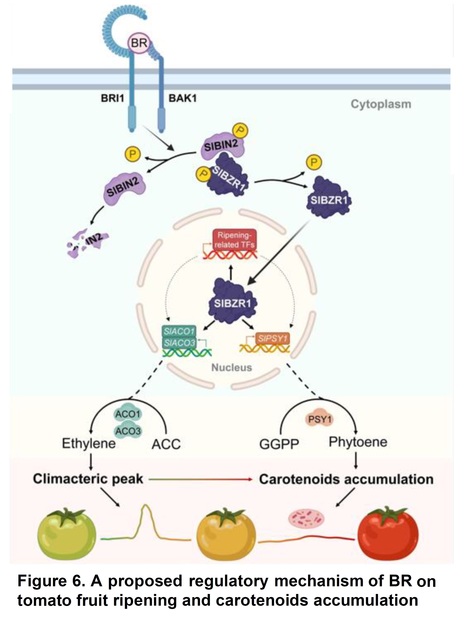
|
Scooped by Julio Retamales |
Authors: Fanliang Meng, Haoran Liu, Songshen Hu, Chengguo Jia, Min Zhang, Songwen Li, Yuanyuan Li, Jiayao Lin, Yue Jian, Mengyu Wang, Zhiyong Shao, Yuanyu Mao, Lihong Liu and Qiaomei Wang.
Journal of Integrative Plant Biology (2023)
Abstract: "The plant hormone ethylene is essential for climacteric fruit ripening, although it is unclear how other phytohormones and their interactions with ethylene might affect fruit ripening. Here, we explored how brassinosteroids (BRs) regulate fruit ripening in tomato (Solanum lycopersicum) and how they interact with ethylene. Exogenous BR treatment and increased endogenous BR contents in tomato plants overexpressing the BR biosynthetic gene SlCYP90B3 promoted ethylene production and fruit ripening. Genetic analysis indicated that the BR signaling regulators Brassinazole-resistant1 (SlBZR1) and BRI1-EMS-suppressor1 (SlBES1) act redundantly in fruit softening. Knocking out SlBZR1 inhibited ripening through transcriptome reprogramming at the onset of ripening. Combined transcriptome deep sequencing and chromatin immunoprecipitation followed by sequencing identified 73 SlBZR1-repressed targets and 203 SlBZR1-induced targets involving major ripening-related genes, suggesting that SlBZR1 positively regulates tomato fruit ripening. SlBZR1 directly targeted several ethylene and carotenoid biosynthetic genes to contribute to the ethylene burst and carotenoid accumulation to ensure normal ripening and quality formation. Furthermore, knockout of Brassinosteroid-insensitive2 (SlBIN2), a negative regulator of BR signaling upstream of SlBZR1, promoted fruit ripening and carotenoid accumulation. Taken together, our results highlight the role of SlBZR1 as a master regulator of tomato fruit ripening with potential for tomato quality improvement and carotenoid biofortification."
Julio Retamales's insight:
This article was already posted here when published as a preprint.
No comment yet.
Sign up to comment



 Your new post is loading...
Your new post is loading...







